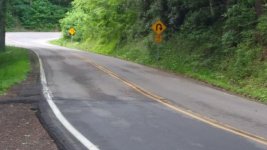-
There were many reasons for the change of the site software, the biggest was security. The age of the old software also meant no server updates for certain programs. There are many benefits to the new software, one of the biggest is the mobile functionality. Ill fix up some stuff in the coming days, we'll also try to get some of the old addons back or the data imported back into the site like the garage. To create a thread or to reply with a post is basically the same as it was in the prior software. The default style of the site is light colored, but i temporarily added a darker colored style, to change you can find a link at the bottom of the site.
You are using an out of date browser. It may not display this or other websites correctly.
You should upgrade or use an alternative browser.
You should upgrade or use an alternative browser.
Well, I'm still doing dumb things
- Thread starter CarolinaSpyderRyder
- Start date
Buckeye Bleau
Active member
Wow, awesome places.
Joe
Joe
wyliec
Active member
Looks like you were in a very scenic, and relaxing place, where you might forget the speed at which you are going. Very nice picture of the spyder in front of the curve. Since I read where many riders say they can double the speed limit for a curve, I have to ask, was there a speed limit for that curve, and did you double it?:yikes:
CarolinaSpyderRyder
New member
blacklightning
Well-known member
Those speed signs are just recommendations anyway.at least doubled the speed limit for that curve (not mentioning any numbers) I did see a sign or 2 up there that said 15 MPH.View attachment 150167
BLUEKNIGHT911
Sadly Passed Oct 2024 - RIP
SIGNS
:agree: ......, Those signs are yellow .... they are caution , warning , recommended Max etc ....... by Law speed limit signs must be white and say Speed Limit .................. Mike :thumbup:Those speed signs are just recommendations anyway.
Bob Denman
New member
But if you happen to have an accident near one of those signs, and they can use "speed not reasonable or prudent for the driving conditions", for writing a summons: then the sign will be more than just mentioned in Court... nojoke
CA Railwhale
New member
speed limit
If the LEO used RADAR to clock you, you can get a court order for the LEOs to release the RADAR speed limit. It's set by averaging actual driver speed, not statute. It's usually quite a bit higher that the posted limit (at least in California)
If the LEO used RADAR to clock you, you can get a court order for the LEOs to release the RADAR speed limit. It's set by averaging actual driver speed, not statute. It's usually quite a bit higher that the posted limit (at least in California)
ARtraveler
R.I.P. Dwayne
Beautiful pictures. Easy to get distracted. :thumbup:
AeroPilot
Member
Nice pics Carolina!
I always enjoy the pics of the mountains and twisties no matter where they are.
Couple of weeks ago, I was daydreaming and got pulled over by a local LEO for 43 in town as the speed had changed to 35 mph. My wife was following on her ride and the officer was quick to mention that she could go... HES the one I'm after . She still reminds me about that. The officer also asked about our SENA's implying I guess that even if I missed the speed limit change, my wife could have warned me which she usually does. He left me off with a warning as I quess he felt I would be chastised and reminded to slow it down ENOUGH! :roflblack:
. She still reminds me about that. The officer also asked about our SENA's implying I guess that even if I missed the speed limit change, my wife could have warned me which she usually does. He left me off with a warning as I quess he felt I would be chastised and reminded to slow it down ENOUGH! :roflblack:
I always enjoy the pics of the mountains and twisties no matter where they are.
Couple of weeks ago, I was daydreaming and got pulled over by a local LEO for 43 in town as the speed had changed to 35 mph. My wife was following on her ride and the officer was quick to mention that she could go... HES the one I'm after
WilderThomas
New member
Above the Limit
Some years ago, I was stationed at Naval Air Station Oceana, Virginia Beach. I had a townhouse which I shared with another, and one weekend, he decided to return home to Philadelphia. On the way back, he was cited for doing 110 in a 35, over the Chesapeake Bay Bridge Tunnel. He had to make it back in time to commence work at 0700 on Monday. I understand that the fine was hefty.
Additionally years ago, I was riding a then new 1977 Honda Gold Wing from East Boston through New York, into Canada, back into Michigan. This was at the time of the federally mandated 55 mph top speed in the States. You can imagine my elation at seeing posted speed limit signs which read, 60, then 80, and finally, 100. So I cranked it up to 100 eventually, and held it there. But it wasn't until later that I found that the speed limits were in kilometers per hour, vice miles per hour.......
Today, I am more in tune with the posted speed limits, and find that the speed limit (80) on I-84, is fast enough for me. I've never been told, what the "all day cruising speed" of the two cylinder 998cc, Spyder is. How fast, CAN one go all day long on the highway without straining the engine?
Had a great weekend in East Tennessee. On my way home however, in the actual county in which I live, I got pulled over and cited for 67 in a 50.View attachment 150162View attachment 150163View attachment 150164View attachment 150165View attachment 150166
Some years ago, I was stationed at Naval Air Station Oceana, Virginia Beach. I had a townhouse which I shared with another, and one weekend, he decided to return home to Philadelphia. On the way back, he was cited for doing 110 in a 35, over the Chesapeake Bay Bridge Tunnel. He had to make it back in time to commence work at 0700 on Monday. I understand that the fine was hefty.
Additionally years ago, I was riding a then new 1977 Honda Gold Wing from East Boston through New York, into Canada, back into Michigan. This was at the time of the federally mandated 55 mph top speed in the States. You can imagine my elation at seeing posted speed limit signs which read, 60, then 80, and finally, 100. So I cranked it up to 100 eventually, and held it there. But it wasn't until later that I found that the speed limits were in kilometers per hour, vice miles per hour.......
Today, I am more in tune with the posted speed limits, and find that the speed limit (80) on I-84, is fast enough for me. I've never been told, what the "all day cruising speed" of the two cylinder 998cc, Spyder is. How fast, CAN one go all day long on the highway without straining the engine?
CarolinaSpyderRyder
New member
I'm not sure how much "strain" youre talking about
The peak of the torque curve is about 5000 RPM. Which is about 70 MPH in fifth gear. Above this point, gas mileage suffers a bit. I will say, I've had it up toward the red line, and it doesn't seem to mind riding there at all. As far as all day goes, I wish I had the opportunity to test it out and see... but 17 MPH over the limit will apparently get me into trouble, so if I say it'll do 87 all day, I'm asking for trouble I guess, but it probably will. .
.
The peak of the torque curve is about 5000 RPM. Which is about 70 MPH in fifth gear. Above this point, gas mileage suffers a bit. I will say, I've had it up toward the red line, and it doesn't seem to mind riding there at all. As far as all day goes, I wish I had the opportunity to test it out and see... but 17 MPH over the limit will apparently get me into trouble, so if I say it'll do 87 all day, I'm asking for trouble I guess, but it probably will.
IdahoMtnSpyder
Well-known member
Anything under the redline. When I had my 2013 RT I rode it hour after hour at 80+.I've never been told, what the "all day cruising speed" of the two cylinder 998cc, Spyder is. How fast, CAN one go all day long on the highway without straining the engine?
BLUEKNIGHT911
Sadly Passed Oct 2024 - RIP
WHAAAAAAAAAAAAAAAAAAAAAAAAAAAAAAAAAAAAAAAAT
Friend that is not how RADAR works ..... and there aren't different versions in Calif., they all work the SAME ..... I ran Radar for decades and the LEO can set the unit to LOCK-ON at OR ABOVE a specific speed ..... however the target vehicle MUST ACHIEVE THAT SPEED.....OR ABOVE IT...... This is a brief explanation, .................. Mike :thumbup:If the LEO used RADAR to clock you, you can get a court order for the LEOs to release the RADAR speed limit. It's set by averaging actual driver speed, not statute. It's usually quite a bit higher that the posted limit (at least in California)
CA Railwhale
New member
EXPLANATION
Friend that is not how RADAR works ..... and there aren't different versions in Calif., they all work the SAME ..... I ran Radar for decades and the LEO can set the unit to LOCK-ON at OR ABOVE a specific speed ..... however the target vehicle MUST ACHIEVE THAT SPEED.....OR ABOVE IT...... This is a brief explanation, .................. Mike :thumbup:[/QUOTE
It's not the RADAR, it's they way they calculate the speed limit. For some reason in California the statute speed limit and the RADAR limit are different. The way it was explained to me by a CHP officer is the RADAR limit reflects actual conditions and driver behavior and the statute is just the law. The officers tend to pick and choose which one they use, if they want a lot of tickets, they pace cars or hide around corners. They can write you based upon pacing or an estimated speed on the statute limit, but if they use RADAR and someone fights it they can lose unless the person was exceeding the computed limit.
BLUEKNIGHT911
Sadly Passed Oct 2024 - RIP
WELLLLLLL NOW THAT YOU MENTION IT
There is no such thing as a " COMPUTED LIMIT " way of deciding whether or not you violated the Posted Speed .... period. But what would I know, I was an LEO for 36 years....... Your knowledge appears to be based on - what you remember ( and your understanding of IT !!! ) from a brief conversation you had sometime in the past......... I'm leaving this conversation now .... Mike :thumbup:Friend that is not how RADAR works ..... and there aren't different versions in Calif., they all work the SAME ..... I ran Radar for decades and the LEO can set the unit to LOCK-ON at OR ABOVE a specific speed ..... however the target vehicle MUST ACHIEVE THAT SPEED.....OR ABOVE IT...... This is a brief explanation, .................. Mike :thumbup:[/QUOTE
It's not the RADAR, it's they way they calculate the speed limit. For some reason in California the statute speed limit and the RADAR limit are different. The way it was explained to me by a CHP officer is the RADAR limit reflects actual conditions and driver behavior and the statute is just the law. The officers tend to pick and choose which one they use, if they want a lot of tickets, they pace cars or hide around corners. They can write you based upon pacing or an estimated speed on the statute limit, but if they use RADAR and someone fights it they can lose unless the person was exceeding the computed limit.
Last edited:
Similar threads
- Replies
- 49
- Views
- 3K
- Replies
- 51
- Views
- 9K
- Replies
- 13
- Views
- 1K
- Replies
- 9
- Views
- 2K






